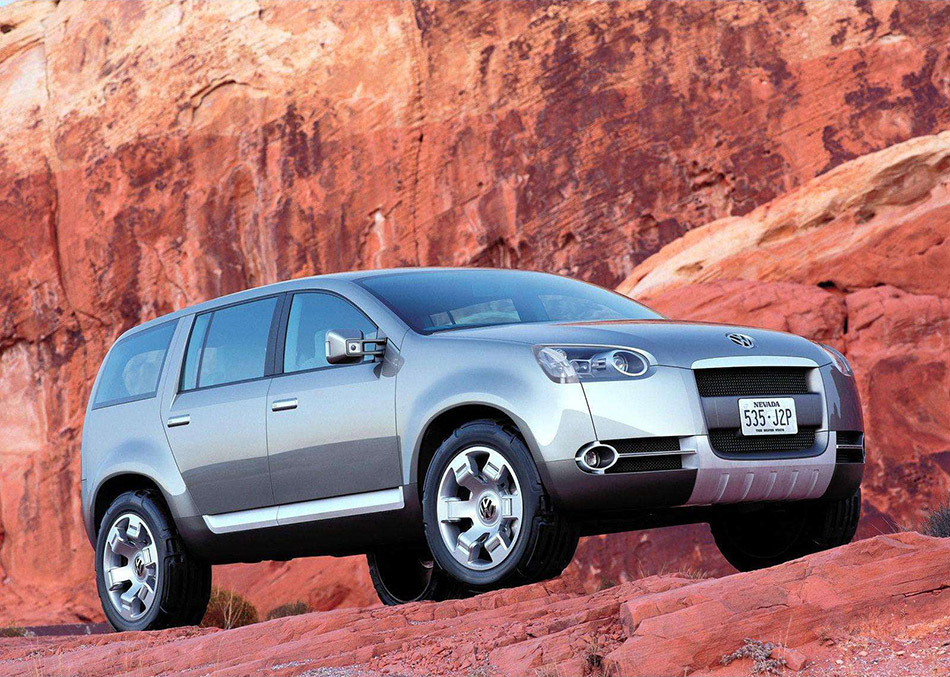Volkswagen has a tradition of giving a preview of an exciting future at the year's first international car show, the North American International Auto Show (NAIAS) in Detroit. In 2001, Volkswagen unveiled the acclaimed Microbus, and in 2000 showed the world the AAC pick-up study. This January, Volkswagen is showing the multi-segment Magellan study - a multi-talented travelling concept for tomorrow's world.
The concept car, named after the Portuguese navigator Magellan, has a W8 engine with a power output of 202 kW / 275 bhp. It has four-wheel drive and pneumatic suspension with active hydraulic shock absorption. These technical features call to mind an off-road vehicle, but that is only part of the picture. This study unites several worlds. Whereas the two previous concept cars could be clearly attributed to a particular segment, this compartmentalisation has been deliberately avoided with the "Patagonia Green" Magellan.

The buzzword today is "crossover". This refers to automobile concepts which unite select features of several segments in one vehicle. The team at the Volkswagen Design-Center Europe in Sitges near Barcelona has brought together the emotional appeal of modern SUVs (sport utility vehicles), the versatility of MPVs (multi purpose vehicles) and the agility of an estate car. They thus created a new species, one that melds the emotional with the rational - travel adventure with economic, intelligent space-saving design.
The length (4,685 mm) and width (1,860 mm) of the Magellan are that of an SUV. Its height (1,620 mm) defines a new type - the concept car is lower than an SUV or an MPV, but higher than an estate car.
The Magellan reflects the wishes of drivers who can not find the ideal vehicle for their complex needs in the classical SUV, MPV and estate car segments, but who appreciate the core characteristics of these vehicle types. These characteristics include high seat position, off-road capability, spaciousness in both the passenger compartment and the luggage compartment, and agile handling. Another essential element is individuality, expressed in an intelligent technical concept and design far away from the mainstream.
The design of the Magellan body has the solid look of an off-road vehicle, the spacious clear lines of an MPV and the dynamic appeal of an estate car. The progressive character of the Magellan was created without the use of obtrusive design elements. However, one design feature is the position of the VW emblem. It has been set in the bonnet, above a newly designed grille, a departure from the traditional position.
Its off-road qualities are demonstrated by emphatic wheel arches, 19-inch six-spoke wheels with 245 Michelin tyres (the PAX system with emergency running mode means a spare wheel is not required), good ground clearance, short overhangs and a relatively long bonnet. Estate car features are harmoniously integrated, underlining the crossover principle. These features include a steeply raked windscreen and, in contrast to SUVs, a low silhouette in the style of sporty estate cars. The MPV aspects are expressed in the car's width and height, its clarity and interior design.
The spaciousness and seating arrangements take their lead from an MPV smaller than the Microbus. The interior is dominated by high-quality, robust materials (Alcantara, leather, aluminium), an unwonted lightness of shapes and seemingly suspended details. In the interior, "Sensitiv" leather is combined with matte polished leather. The colours: the light green of "Green Tender" and the darker green "Trinidad".
The instruments and controls are not part of a classical cockpit, but are suspended in a horizontal information and control bar between the dash panel base and hood. Another nice touch: the Magellan has a navigation system, the "GPS to Go" system which can be removed for off-road route guidance.
Innovative features are also to be found in the seats. The Magellan has three rows of seats for a total of six people. The front and middle rows have individual seats, whereas the third row has a bench seat. A monorail frame underneath the seat and the lengthways guide rail integrated in the wooden floor allows best-possible use of the available space. It also creates the impression that the seats "float" in the same way as the instrument panel. The third row of seats can be stored in the floor when not in use.
Source: Volkswagen













